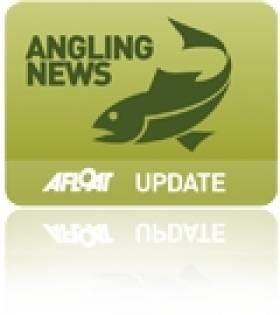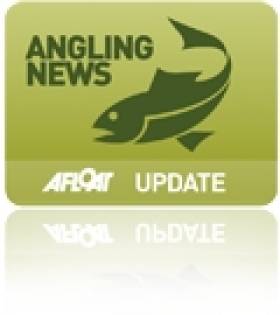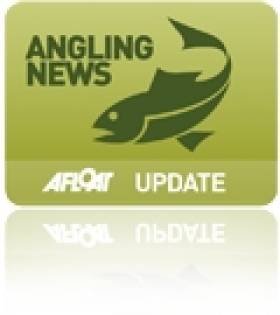Displaying items by tag: angling
Divers Find Body In Search For Missing Angler
#NewsUpdate - TheJournal.ie reports that Naval Service divers yesterday recovered a body from the sea off Co Clare during the search for a missing fisherman.
As reported Monday on Afloat.ie, the Latvian national was angling with friends near Fanore when he was swept off the rocks by an unexpected wave.
A major search and rescue operation was launched soon after but interrupted due to adverse weather and sea conditions on Sunday evening and Monday afternoon.
However, divers retrieved a body from the water some two hours into the resumed search yesterday morning (Tuesday 8 October). Formal identification of the remains is pending.
Bluefin Tuna Anglers Should Put Conservation First
#Angling - Inland Fisheries Ireland (IFI) has urged marine sport anglers to put conservation first when it comes to the endangered bluefin tuna - particularly those in the tuna hotspot of Donegal Bay.
In a statement, the national fisheries body said: "For a long time, Ireland has been recognised for its marine sport fishing. The vast variety and quality of our angling has given the country a reputation of which we are justly proud."
Bluefin tuna catches by the commercial fishing fleet targeting other species were first reported in the 1980s, and such reports became quite common on the west coast by the mid 1990s, though no fish fell to rod and line until 2000.
The following year, a new Irish and European record was set by Adrian Mulloy, fishing with skipper Michael Callaghan. On the 5 October 2001 Adrian caught a fish of 968lbs near Rathlin O’Beirne Island.
In 2002 and 2003, more bluefin tuna were caught and one boat contributed to the 'Tag a Giant' programme run by Stanford University and supported in Ireland by Bord Iascaigh Mhara (BIM).
"While these were heady days for big game fishing in Ireland, it all happened against the backdrop of a global decline in a species that is now famously threatened by overfishing," said IFI.
In 2012, European regulations governing the harvesting of bluefin tuna were changed as the species became even more endangered.
Ireland does not have a bluefin tuna quota, and for this reason "no allocation is available for sports or recreational fishing," said the IFI statement. "Furthermore, there is no facility in Irish fisheries regulations to permit angler-caught bluefin tuna to be landed into any Irish port, and there is no provision for the sale of these fish.
"While IFI would love to see the development of a sustainable fishery for this wonderful species, given the continued significant decline of the species and the fragile nature of the stock, the key imperative has to be one of conservation."
Flycasting Festival Lands Limerick a Reel Gathering event
#flycasting – The story of one a former World Champion from Limerick will be celebrated in a new festival In Castleconnell, details of which were announced today.
The John Enright Castleconnell Flycasting Festival will attract dozens of competitors from all over the world to the banks of the River Shannon in Castleconnell from Friday 11th to Sunday 13th October, 2013.
The inaugural event, which culminates in the Spey O Mega International Flycasting Championship, forms part of the Gathering Ireland 2013 project.
In 1896, local man John Enright became the Fly-Casting Champion of the World at Wimbledon Park Lake in England for Distance Casting Competition. He also won First Prize in all five events on that famous day. From 1890 to 1905 his success rate at Fly Casting on the International Circuit was phenomenal. The three-time World Champion, his World Record distance of 186 feet with a 20 foot Castleconnell Rod at Central Park in New York also stands today.
According to festival organiser, John Mac Namara: "John Enright's international exploits brought fame and glory to his native village of Castleconnell. Castleconnell Fishery became an International Fishing Centre and home of the famous Castleconnell Rod, while Castleconnell village was referred to as 'Little Paris'. This event is our way of celebrating this local figure and his contribution to putting Castleconnell on the international map."
Mr. Mac Namara added: "The event will feature fly-fishing instruction for all the family; an exhibition of fly-casting by 2010 World Flycasting Champion Ruairi Costello from Scarriff, an exhibition of John Enright memorabilia, riverboat trips; guided walks; street-based and evening entertainment; and a display of fly-fishing and casting by amateur and professional fishermen, culminating in the Spey O Mega International Casting Championship, which will attract expert competitors from around the world."
The John Enright Castleconnell Flycasting Festival is one of 161 Gathering Limerick festivals and events taking place during 2013. The Programme of events is being coordinated by the Limerick Gathering Team at City Hall. Other events scheduled to take place during the coming weeks include the Legends International Tag Rugby Festival (25-26 Oct), Limerick International Fashion Design Week 2013 (29 Oct-1 Nov), and Richard Harris International Film Festival (6-8 Dec).
For more see visit www.johnenrightfestival.com
Ireland's Best Spots For Angling Holidays
#Angling - Looking for a spot to cast your line in Ireland this winter? IrishCentral has you covered with their list of the best places in Ireland for a fishing holiday.
Boasting a climate that's (usually) kind to anglers all year round, Ireland is the perfect location for anyone planning their dream angling vacation or even a last-minute getaway.
And being only a few hours by road from end to end, you're never too far away from your pick of the catch, whether it's Lough Corrib's famous salmon and trout, codling at Rosses Point or even bluefin tuna in Donegal Bay.
Indeed, it's little wonder why angling tourism is worth three-quarters of a billion euro to the Irish economy each year.
IrishCentral has much more on the story HERE.
And for more specific details, the Huffington Post has a great guide to fly fishing in Ireland.
'Screaming Reels' Wins Again At Rosslare Small Boat Angling Fest
#Angling - Irish boat Screaming Reels has won the Rosslare Small Boats festival for the third year in a row.
In a fantastic finale, the boat from Rosie’s Sea Angling Club in Cork won the competition with 27 different species of fish, beating 25 other boats from Britain and Ireland.
Screaming Reels are a mighty force to be reckoned with in the small boat sea angling scene in Ireland and Britain, having won this competition five out of the last six years.
Sponsored by Inland Fisheries Ireland (IFI), Fáilte Ireland, DAIWA Sports UK and Sea Angler magazine, the event – now in its 28th year – attracted more than 70 anglers from the Isle of Wight, Southport, Liverpool, Wales and Ireland.
Weather conditions proved to be challenging for the competition with blustery winds making boat fishing difficult. However, as the week wore on, conditions improved and competitors managed to fish the full four-day competition by launching their boats twice from Kilrane in Rosslare and twice from Kilmore Quay.
The competition ended on a high note with the final day’s fishing taking place from Kilmore Quay, where anglers could target all species, making it a very exciting finish.
Organisers went out of their way to facilitate boats getting the full four day’s fishing in by organising early morning launches which proved to be a big hit with competitors.
This fantastic finale brought great excitement to the competition. The overall results demonstrated this with first place going to Screaming Reels (Martyn Rayner, Seirt Shults, Neville Murphy from Rosie’s Sea Angling Club in Cork) with 27 species for 22.86kg.
They were followed closely in second place by Jay Jay (Andrew Jones, David Jones and Steve Jones from Newport in Wales) with 26 species for 18kg. In third place was Shy Torque (Kevin Martland, Kenny Carr and Gavin Parker from Liverpool) with 25 species for 21.24kg.
A great variety of fish were recorded during the week, with 37 different types of species including coalfish, dogfish, dab, flounder, pollack, bull huss and some unusual species such as black goby, shanny, black bream and painted ray.
A specimen garfish, which was close to the Irish record weighing 0.92kg was caught by Steve Jones from Newport in Wales. A shore rockling of 0.66kg caught by Mark Rogan of Rogie’s Girl from Liverpool was a near specimen (pending verifiication by the Irish Specimen Fish Committee).
The heaviest round fish was a conger of 7.46kg caught by Ian Jenkins of Sandstorm from Wales, who was also awarded a perpetual trophy sponsored by Inland Fisheries Ireland for the biggest fish caught of the week. The heaviest flat fish was a flounder of 0.58kg caught by Richie Stead from Nirvana.
This year there were two juniors in the competition: 16-year-old Lewis Radcliffe from Wigan, aboard the boat Cod n Bass, who had 18 species for 15.08kg; and James Cherry (16) from Dunshaughlin, Co Meath aboard the Irish boat Fin Chaser, a newcomer to the competition who had 17 species for 13.88kg.
Redmond’s The Bay in Rosslare Strand hosted the prizegiving ceremony, and IFI cited the hospitality of John Redmond and his staff as "outstanding". Other sponsors included Widgeon’s Rest Tackle shop in Rosslare Strand; Shamrock Tackle; Kilmore Quay Harbour office; and the Small Boat Owners Association at Rosslare Safe.
The total prize fund for the competition was €10,000 including fishing equipment and substantial monetary prizes and engraved trophies. The prizes were presented by Fergus O’Dowd, Minister of State at Department of Communications, Energy and Natural Resources, and Orla Woods, angling product manager at Fáilte Ireland.
Minister O’Dowd said: "I am delighted to be at this fantastic fishing festival and to see so many of you here from all over Britain and Ireland. I know that many of you are very loyal visitors to Ireland, coming here to fish year after year.
"The festival is very important not only to promote the great sea fishing we have on the East Coast, and in particular, the variety of species available but also the investment it brings to the local businesses in the area each year. I would like to congratulate all competitors for their participation in this competition and encourage you to spread the word to your friends about fishing in Ireland."
Next year’s event will take place from 6-13 September 2014, and IFI invites all small boat anglers to take part. Further information is available from Josie Mahon at IFI who can be contacted at 01 278 7022 or [email protected].
Brit Angler Does Double At Inniscarra Lake
#Angling - Manchester angler Trevor Platt became the second competitor to claim the Vintners' Cup twice at the Inniscarra Lake coarse angling festival recently, as the Irish Examiner reports.
Platt's win marked the beginning of a busy few weeks on the Co Cork waterway, beginning with the O'Callaghan's Open on 25 August to the Hackett Cup concluding on 13 September last.
The Irish Examiner has more on the latest angling news from the south-west HERE.
Invasive Species Questionnaire for Ireland's Anglers
#InvasiveSpecies - When invasive aquatic species become established, they cause significant damage to freshwater ecosystems, fish populations and to the economies that depend upon them.
Next to habitat loss, invasive species are considered the greatest threat to native biodiversity. Anglers play a vital role in protecting the native and unique fish stocks and waterways on the island of Ireland.
Inland Fisheries Ireland and the Institute of Technology Sligo are looking for anglers to take a short online questionnaire on angling and invasive species.
The questionnaire should take no more than 8 minutes and can be completed anonymously. Your views would be greatly appreciated.
'Broad Pattern Of Life Emerges' In Celtic Sea Trout Project Findings
#CelticSeaTrout - Minister Fergus O’Dowd joined anglers, environmentalists and fisheries scientists at the Westcourt Hotel in Drogheda on Tuesday evening (17 September) to hear some of the key findings of the Celtic Sea Trout Project, which was funded mainly by the EU under the INTERREG 4A Ireland-Wales Programme.
The enigmatic sea trout is a highly prized angling species, and to many anglers it is regarded as a fish which offers better sport than the salmon.
Sea trout support and sustain important and valuable fisheries throughout the study area of the Celtic Sea Trout Project (CSTP) launched two years ago, comprising the full extent of the Irish Sea and its contributing rivers and selected systems along the south coast of Ireland.
Ireland is blessed with sea trout fisheries, but other angling treasures, although well known locally, have emerged over the course of the project. Individually, these sea trout fisheries on both our major and lesser rivers have the potential to generate small but important social and economic benefits within local communities. Collectively, their importance and value at a regional and national level may be far greater than generally realised.
In addition to its angling value, the sea trout is a unique and potentially valuable indicator of environmental change and the quality of the aquatic environment, and this potential was fully investigated during the project where the marine ecology of sea trout was a key focus.
The CSTP is a unique project in which the scientists worked closely with anglers, fishery owners and inshore and offshore marine fishermen throughout the entire region bordering the Irish Sea and provided the required feedback to keep all informed about the project and the collective sea trout populations within the study area.
Congratulating all those who contributed to the CSTP, Minister O’Dowd said: “From the outset it was clear that the Celtic Sea Trout Project represented a major step forward to achieving our ultimate goal of maintaining healthy fish stocks that support biodiversity, sustainable fisheries and provide optimum benefits for the general community as a whole.”
From sea trout scales provided by anglers and others, a broad pattern of life histories emerged. This was of faster growth and higher survival (more multiple spawners) in southern Wales rivers; high survival, but somewhat slower growth in the northwest England rivers; and lower survival off the Irish coast, where finnock (fish returning in the same year that they smolted) dominated the runs in most rivers. The Currane system in Kerry was a notable exception, with a high proportion of long-lived adult sea trout.
The comprehensive genetic study found nine principal regional groups within the data set and clear differences in the areas that these groups occupied during their marine feeding migration, although there were also examples of substantial exchange rates between them. This was demonstrated by some migrants which were recorded up to 300km from their river of origin.
Family Of Missing Angler Arrive In Northern Ireland As Search Continues
#Missing - The search continues on the North Antrim coast for a missing man thought to have been swept out to sea while angling at the weekend.
The man has been named as 38-year-old Polish national Jaroslaw Andrykiewicz, who had been living in Northern Ireland for six years and worked at a vegetable produce firm in Co Armagh.
BBC News reports that the family of the missing man have arrived in Northern Ireland as search and rescue services continue to comb the coast around Ramore Head in Portrush, where he was last seen.
The search for Andrykiewicz had been slowed earlier this week by the stormy conditions in the region.
Kids Prove Their Mettle at Junior Pike Angling Nationals
#Angling - It was the girls and little ones who made the biggest mark at the National Junior Pike Angling Competition in Monaghan recently when 14-year-old Ashlyn McCabe and five-year-old Eoin Sheehan were named angler of the year in their respective categories.
Sixty-eight boys and girls from all over Ireland competed for the title in two age categories, under 13s and under 18s at Shantonagh Lough, near Carrickmacross, on Saturday 7 September.
Heavy rain and wind made fishing conditions on the day difficult, but this did not deter the youngsters, all of whom stuck out the tough conditions. A total of 15 pike were caught, ranging in size from 8ozs to 8lbs 15ozs.
In what was a close competition from start to finish, the winners were awarded the National Junior Pike Angling Cup, sponsored by Irish Federation of Pike Anglers, plus a trophy from Wee County Trophies and tackle equipment. All competitors received a medal sponsored by Inland Fisheries Ireland (IFI).
Ashlyn McCabe from the Newry Pike Angling Club topped a highly competitive field to take the under 18 title, also capturing the heaviest bag accolade with an impressive 9lb 15oz catch. Behind her in second place was Luke Everard, while third was Harry McCooey and fourth Sean McCooey.
In the under 13 section, Eoin Sheehan from Dun na Ri Angling Club in Co Meath bested five-year-old Cliodhna McKenna from Keady and District Angling Club.
In the team event, McCabe's club Newry placed first, followed by Keady & District Pike Angling Club and Newgrange Active Angling club. Heaviest fish of all of the qualifiers went to 13-year-old Jamie O’Reilly from Newgrange Active Angling Club, with a pike of 11lb 15oz caught from the Dromore system in Ballybay.
Minister of State Fergus O’Dowd joined IFI chief Dr Ciaran Byrne to present the prizes, trophies and medals on the day. The minister congratulated all the youngsters who took part, stating how delighted he was to see so many young people at the competition from all over Ireland: Tullamore, Newry, Dublin, Longford and Ardee.
He thanked Brendan O’Reilly and the team from the Irish Federation of Pike Anglers who worked tirelessly to organise the event, and all parents and volunteers involved.
The National Junior Pike Angling Competition was sponsored by IFI, the Boyne Angling Centre and the Irish Federation of Pike Anglers, and organised by the Pike Angling Federation.
































